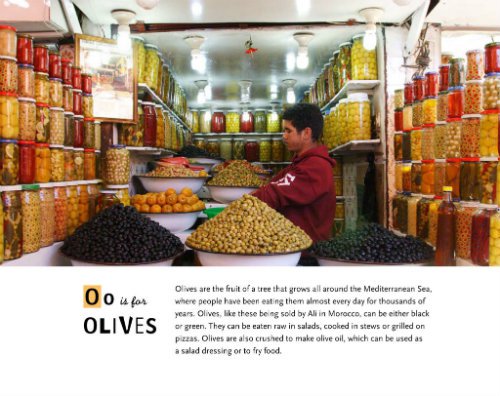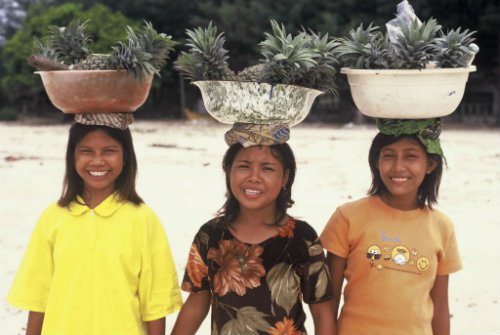#46 in an ongoing series of posts celebrating the alphabet.

Fancy some Moroccan dates, farm fresh eggs from France, bananas from the Caribbean? How about a stroll through the street markets of Burma, Guatemala and England? Now, I know that if you chanced upon a particular street vendor in Thailand, you’d surely insist on a bowl of yummy noodles. Sitting around a low table on your plastic stool, you’d likely find the happy conversation every bit as satisfying as the food.

Acclaimed UK food and travel writer and photo journalist Chris Caldicott serves up an international feast for the senses in his photographic alphabet of world food. He takes us to Europe, Asia, Africa and the Americas, giving us a fascinating glimpse of how food is grown, transported, sold, cooked, eaten and shared. Far more than a standard “A is for Apple” compendium, each photograph in World Food Alphabet (Frances Lincoln, 2012) tells a story with an interesting cultural and geographical context, showing people interacting with particular foods in their everyday lives.
It will be fun for a young reader to venture far from the antiseptic mega supermarkets he’s likely used to in the United States to observe another child helping his family sell bananas or limes in an outdoor stall, to consider what it would be like to collect water every day from a village pump, or to experience the sights, smells, and sounds of a bustling farmers market where he would have to barter for all his purchases. What if his job every day after school was to tend to the goats or go fishing for his family’s dinner?
Caldicott uses single photos or photo collages for each letter of the alphabet to showcase a specific food or food-related essential (journeys, kitchens, markets, quantities), paired with a concise paragraph describing how the food is commonly eaten, obtained, processed and/or prepared. He also unobtrusively slips in a nod to healthy eating habits (the value of fresh fruit and veggies, or honey over refined sugar, etc.). The emphasis is on whole foods, fair trade, sustainable crops, and conservation.


I love the cultural diversity, seeing all the smiling faces, and celebrating the many colors, textures, shapes and sizes of certain foods (longest yams I’ve ever seen in my life, Caribbean). Though the places might be new to kids, they will recognize many of the foods (tomatoes, bananas, eggs, fish, rice), see them in a totally different context, and be naturally motivated to make comparisons.
Caldicott, who is Photographer-in-Residence to the Royal Geographic Society, has traveled to 100 different countries documenting the vanishing lifestyles of indigenous peoples in some of the most remote regions of the world. His photos shine with humanity and will likely inspire kids to want to learn more about the people and places in the book.

I especially enjoyed reading about coconuts and pineapples, two fruits commonly associated with my home state of Hawai’i. I had never imagined coconut husking in Sri Lanka or women in Bali balancing bowls of pineapples on their heads. It makes perfect sense, of course, but Hawaiians have yet to catch on. 🙂
World Food Alphabet would make a valuable addition to any school library, prompting many interesting discussions and even whetting the appetite for a variety of ethnic foods.
I really want a bowl of noodles now.
* * *
 WORLD FOOD ALPHABET
WORLD FOOD ALPHABET
by Chris Caldicott
published by Frances Lincoln Children’s Books, 2012
Nonfiction Picture Book for ages 5-8, 32 pp.
Cool themes: food, cultures, diversity, social studies, cooking, agriculture.
* * *
♥ More Alphabetica here.
![]() Certified authentic alphabetica. Handmade with love and traveling taste buds.
Certified authentic alphabetica. Handmade with love and traveling taste buds.
———————————————
Copyright © 2013 Jama Rattigan of Jama’s Alphabet Soup. All rights reserved.

This looks wonderful, Jama. I’ll pass the idea on to several who do food things at school, & to our librarian. My daughter works at the Museum for Contemporary Art, which hosts lectures called mixed-taste (she does a lot of food events). I saw a man named Dan Koeppel speak there a couple of years ago about bananas & how we in the US see so few varieties (of which there are many) because of the main companies’ monopolies. Here is an interview on NPR with him & about his book, Banana: http://www.npr.org/2011/08/30/139787380/bananas-the-uncertain-future-of-a-favorite-fruit Thanks for sharing the World Food Alphabet!
LikeLike
Thanks for the link, Linda — Dan’s book looks fascinating! Didn’t know bananas were so susceptible to disease. I was just noticing the other day how the organic bananas we sometimes buy don’t taste as good as the regular ones. You’d think they somehow would be tastier, but maybe it’s the type of banana and not the organic factor. Sounds like your daughter has a very interesting job!!
LikeLike
Another delicious title, Jama. I posted it on Twitter.
LikeLike
Thanks, Margie!
LikeLike
Ooh, I like this very much indeed. Need to keep the little ones apprised of the larger world, and I think this is a Day 1 way to start. Lovely.
LikeLike
Yes, so important to be aware of the larger world. I think this applies equally to grown ups too :).
LikeLike
Wonderful feature, Jama. I especially love the photo of the olives.
LikeLike
That’s one of my favorites too, Kathleen. I was happy that the publisher sent it to me when I requested to share it :).
LikeLike
What a lovely, colorful celebration of food, culture, and diversity – and an inviting introduction to a balanced diet.
LikeLike
Exactly so, Dorothy — well worth reading and sharing :)!
LikeLike
I have a growing collection of alphabet books myself, Jama. This one looks like a keeper. Love the photographs and the fun-filled facts. 🙂
LikeLike
Mr. Caldicott seems to be quite an adventurer. Must be fascinating to travel to such remote places to see how others live and eat. Lucky for us that he’s been documenting his experiences all along with such brilliant photography.
LikeLike